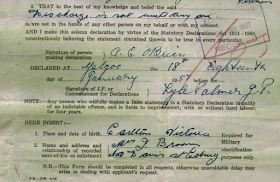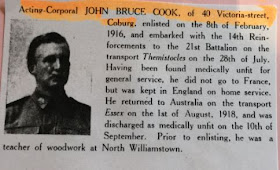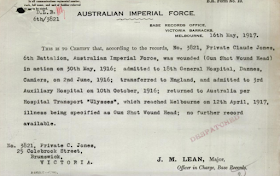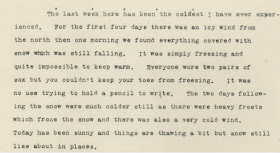William Knox Cooper, born Hotham (North Melbourne) in 1893 and his younger brother Edgar Robert, born Hotham in 1898 were both members of the Coburg Cycling Club, although they came from Fitzroy.
When 3712 Pte William Knox Cooper, 6th Battalion, 12th Reinforcements, enlisted on 7 July 1915 he was 22 year old bootmaker living in Fitzroy. He embarked on 23 November 1915 on board HMAT A40 Ceramic. There were Coburg servicemen sailing on the same ship - William Irons, Cyril Jolley (KIA September 1917), Frederick Buzaglo, Jack Sheehan, Gerald Roberts, Frederick Atkinson (DOW March 1917) and William Alexander (DOW August 1918). It's just possible, then, that these men met on the ship and had a chat about the suburb they had in common - Coburg.
Troops embarking at Port Melbourne on A40 HMAT Ceramic, c1915. The wharf is crowded with soldiers waiting to board the troopship. William Cooper was probably one of those men. Image courtesy AWM. Image H19500.
Cooper sustained gunshot injuries in August 1916 and was sent from France to England to the Trent War Hospital (at Stoke-on-Trent in Staffordshire).
Returned to Australia in November 1916, William Cooper was discharged the following February. One part of his record says he was injured in the leg, another in the feet and yet another in his arm. Whatever the case, on his return it appears he did not go back to cycling. He returned to his former trade of shoemaker, married Ruth Lerwill in 1931 and died in 1973 aged 80.
When William's brother 6243 Pte Edgar Robert Cooper, 6th Battalion, 20th Reinforcements, enlisted on 11 January 1916 he was an 18 year old tailor living in Fitzroy. He embarked on HMAT A14 Euripides on 11 September 1916. Victor Rogers and William Pascoe (KIA May 1917), both Coburg men, were also on board.
In September 1917 Edgar suffered from gunshot wounds (his left clavicle was broken) and shell shock (he'd been buried alive). He was 19 and had already survived considerable neck trauma from a knife wound inflicted by his mother during a pyschotic episode when he was three years old.
The Cooper brothers' mother was born Sarah Jane Knox, daughter of James Knox JP of Union Avenue, Northcote who died in July 1901 aged 69 and was buried at Coburg Cemetery.
Not long after Knox's death, in late August 1901, Sarah Jane Cooper was taken from her home in North Melbourne (with her youngest child Edgar) to stay at the Knox family home in Northcote because the family was concerned about what they saw as 'signs of approaching insanity'. Here she was looked after by her brother Thomas and mother Eliza. There had been no symptoms until three weeks earlier, just after her father's death. Now, she had cut her son's throat and it was only through the intervention of her brother and mother that the child's life was saved. Later she remembered nothing of the incident, but she was admitted to Yarra Bend Asylum where she eventually recovered and was released in March 1902. (Argus, 26 August 1901, Herald, 2 September 1901, Bendigo Independent, 3 September 1901, Yarra Bend Asylum records)
After her husband Edmund Cooper's death in 1904, Sarah married again (in 1911) to James Flett. Despite the dramatic events in their early lives, the Cooper brothers lived at home with their mother and step-father until they enlisted. Their mother Sarah died in 1930 at Cheltenham aged 69.
Stoke-on-Trent War Hospital. (By coincidence, my father was a student at Hanley High School (part of Stoke-on-Trent) during the years of World War One. He vividly remembered zeppelin raids in the area in early 1916 when he was 11 years old. He and his friends thought they were very exciting. No doubt the adults had different ideas.)
Returned to Australia in November 1916, William Cooper was discharged the following February. One part of his record says he was injured in the leg, another in the feet and yet another in his arm. Whatever the case, on his return it appears he did not go back to cycling. He returned to his former trade of shoemaker, married Ruth Lerwill in 1931 and died in 1973 aged 80.
From William Knox Cooper's WW1 file, courtesy NAA.
When William's brother 6243 Pte Edgar Robert Cooper, 6th Battalion, 20th Reinforcements, enlisted on 11 January 1916 he was an 18 year old tailor living in Fitzroy. He embarked on HMAT A14 Euripides on 11 September 1916. Victor Rogers and William Pascoe (KIA May 1917), both Coburg men, were also on board.
Troops on board HMAT Euripides (A14) prior to departure, May 1915. A group of nurses stand at the rail, centre foreground. Image courtesy AWM. Image PB0381.
In September 1917 Edgar suffered from gunshot wounds (his left clavicle was broken) and shell shock (he'd been buried alive). He was 19 and had already survived considerable neck trauma from a knife wound inflicted by his mother during a pyschotic episode when he was three years old.
Edgar was sent home and discharged in June 1918. It appears that, like his brother William, he did not return to the Coburg Cycling Club. He lived at home in Fitzroy until 1937 then moved to Kew. He married Kathleen Colger in 1947 and died at Newtown, Geelong in 1986 aged 88.
Their older brother 7460 Pte Francis Henry Cooper, 5th Battalion, 25th Reinforcements, enlisted on 2 July 1917. He was a 26 year old labourer who was born in Preston and like his brothers gave their mother, Mrs Sarah Jane Flett of 9 Leicester Street, Fitzroy as his next of kin. He survived the war, returning to Australia in July 1919. Written on his record at a later date, but undated 'Soldier stated to have been killed in a railway accident.' I searched the TROVE newspaper collection for a report of this event without success. The Victorian Death Index states that he died at Melbourne East (so most likely in hospital) in 1928 aged 38.
---
The Cooper brothers' mother was born Sarah Jane Knox, daughter of James Knox JP of Union Avenue, Northcote who died in July 1901 aged 69 and was buried at Coburg Cemetery.
Not long after Knox's death, in late August 1901, Sarah Jane Cooper was taken from her home in North Melbourne (with her youngest child Edgar) to stay at the Knox family home in Northcote because the family was concerned about what they saw as 'signs of approaching insanity'. Here she was looked after by her brother Thomas and mother Eliza. There had been no symptoms until three weeks earlier, just after her father's death. Now, she had cut her son's throat and it was only through the intervention of her brother and mother that the child's life was saved. Later she remembered nothing of the incident, but she was admitted to Yarra Bend Asylum where she eventually recovered and was released in March 1902. (Argus, 26 August 1901, Herald, 2 September 1901, Bendigo Independent, 3 September 1901, Yarra Bend Asylum records)
After her husband Edmund Cooper's death in 1904, Sarah married again (in 1911) to James Flett. Despite the dramatic events in their early lives, the Cooper brothers lived at home with their mother and step-father until they enlisted. Their mother Sarah died in 1930 at Cheltenham aged 69.







































